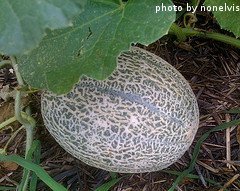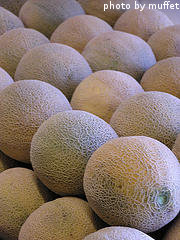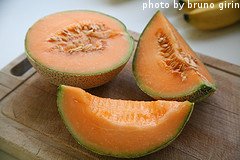Harvesting Cantaloupe
When harvesting cantaloupe, the most important factor is determining that the fruit is ripe and ready to be picked. If you pick cantaloupe too early, it won't be as sweet and the flesh won't be very tender. If you wait too long to pick it, the flesh will be too soft and mealy.
Don't water your cantaloupe plants the last week or so before harvesting them. This will allow the plant to concentrate the sugars and make for much sweeter melons.

There are a few things to look for to determine if your cantaloupe is ready for harvest. First, look at the color of the melon. In most varieties, there is a netting pattern that covers the second layer of rind. Look through the netting to determine what color is underneath. If it looks green behind the netting, the cantaloupe is not ready for harvest. If the rind behind the netting is a yellow or cream color, the melon is ready to be picked. In some varieties, the green color never completely disappears, but it just turns a lighter color instead.
If the rind has turned creamy yellow, it's time to smell the cantaloupe. Put your nose right down to the blossom end and take a whiff. There should be a musky odor emanating from the melon. If you don't smell anything, the melon is probably not ready to be picked. This musky odor is why some people refer to cantaloupes as "musk melons". When you smell the end of a perfectly ripe melon, there will be a definite musk fragrance, but it won't be overpowering. If the smell of the melon is overwhelming, it is probably a bit over-ripe.

Finally, to determine the right time for harvesting watermelon, inspect the appearance of the the stem. A crack should appear that goes around the entire base of the stem. The melon should easily slip off the vine where this crack occurs. Press gently on the stem to see if the melon detaches. If it slips off, the melon was ready to be picked. If the melon resists slipping off the vine, let it sit for another day and check it again. A ripe cantaloupe will easily slip off the stem, leaving a small indentation where it was attached. Sometimes, you might find that a melon has already slipped off the vine on its own. This melon will likely be a bit over-ripe, but still worth cutting into just to see if it's still good enough to eat.
After harvesting cantaloupe, store the whole melons in the refrigerator. They will last for up to a week. Cut cantaloupe will last for 4-5 days before starting to go bad. If you have lots of melons and have no hope of eating them all, you can always freeze them for later use in cool drinks, smoothies or soups. Simply remove the seeds and rind and cut the melons into bite-sized pieces. You can also use a melon-baller to cut up the cantaloupe. At this point, we like to spread out the cut melon pieces in a single layer on a sheet tray lined with parchment paper and freeze them that way. Once they are frozen, they can be transferred to an air tight bag or container. This way, they won't stick together and you can just out the pieces you need. If you freeze the melon pieces all together in the bag, they usually end up as one big frozen clump and are difficult to separate. The frozen melon pieces will last for up to 6 months in the freezer.
Another option for freezing cantaloupe is to remove the seeds and rind and then cut the melon up into pieces that can go into a food processor. Puree the melon up into a thick liquid form and then freeze it for later use. We like to pour the pureed cantaloupe into ice cube trays and freeze it that way. Once frozen, you can take out the melon cubes and store them in an air tight bag or container. Again, this makes it easier to remove just a small amount of cantaloupe from the freezer at a time.
The frozen cantaloupe cubes work great to make various cocktails and smoothies. Cantaloupe pairs very well with ginger, mint and lime. We've even heard of people using cantaloupe puree in combination with coconut milk to make popsicles, but we've never tried it ourselves.
When they are done producing, you can remove the cantaloupe vines from your garden and add them to your compost pile. We usually use a weed whacker to chop up the vines a little bit first because it helps them break down faster.

Now that you know about harvesting cantaloupe, it's time for a few of our favorite recipes that feature cantaloupe.
Click here for some of our favorite cantaloupe recipes
Click here to move from our Harvesting Cantaloupe page to our Growing Cantaloupe main page
Click here to go to our Home page